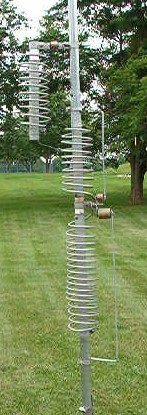 Butternut Notes
Butternut Notes Butternut Notes
Butternut Notes

REVISED - 4-22-15 Since I began QRP operation in March 2005, the performance of this antenna has become more remarkable. With 2 watts out on 40 meters I have worked stations as far as The Azores, Germany, and The Canary Islands. With 1 watt out on 20 meters I have worked 3000 miles to Alaska and Europe. This with an old Heath HW-8 that is not the most sensitive receiver available.
I've used the Butternut HF-6V since about 1987. It has been put up in several locations and in several forms. It has been roof-mounted, pole-mounted, and now, ground mounted. It has never worked better than it is working now.
In the first installation it was mounted on the roof of a ranch type home with a chimney mount and the Butternut Stub-Tuned-Radial Kit. These four radials should have allowed the antenna to operate on 40-10 meters with the efficiency approaching that of a ground-plane.
The next installation was similar except the antenna was mounted on a 15 foot mast using the STR Kit and 2 65 foot wires as 80 meter radials.
The antenna is currently ground mounted with attention to a good radial system. Again, it has never worked better! The current system includes 32 radials, each 35 feet long forming a nearly perfect 70 foot diameter circle. These radials were put down on top of the grass in December 2003 and by Spring 2004 they had pretty much disappeared into the thatch. No problems mowing or walking over the area. Plans were to add more radials however I think that I have reached the point of diminishing return. Also, it is easy to remove the top section for tuning of 15 and 10 meters from a 6 foot stepladder when ground mounted and tweaking the coils for 80 thru 20 can be done easily standing on the ground.. The 80 meter adjustment is very sensitive and changes slightly with temperature. Re-tuning is simple, though.
If vertical antenna efficiency is indicated by a narrow bandwidth, then this installation should be efficient. On 80 meters the antenna is 2:1 SWR over only about 20khz. A tuner can be used for minor frequency excursions, but coax losses are too great to take it to the other half of the band. On 40 meters it is either a CW Band or Phone Band antenna. A tuner can be used here to cover the rest of the band. This doesn't seem to affect performance much - only convenience. Bandwidth on all of the other bands is sufficient for sll band coverage.
As you can see in the picture, my Butternut has been beat up pretty good. Between a number of Field Day operations and some rough handling during storage, the large coils are not perfect anymore. But this antenna performs very well no matter what.
This brings me to my point. I think this antenna is mechanically a little shaky. I believe that it must be guyed. I cannot imagine it in a 40-50 MPH wind without some light, sturdy guys at the 12 foot point. Here is how I guyed mine and my thinking behind it. (See picture below) I put 3 wooden posts symmetrically around the base of the antenna 8 feet out. I used landscape timbers put in concrete only about 24 inches deep. These stand about 24 inches above ground as an attachment point for the light nylon guy line. Elevating this anchor point for the guys makes the antenna very easy to mow around and walk around. Plus, it lessens the angle of the guys decreasing the amount of down force the guys create.
I have found it necessary to clean some of the connections and joints periodically. I would make this a Spring and Fall project. I have secured one of the tube joints (right above the matching coils) with sheet metal screws. This joint always seemed to get corroded and black, perhaps from arcing.
The present trend in some verticals is to advocate 'elevated feed points' and 'counterpoises' in lieu of ground radial systems. I have read the literature and it all sounds believable to me. I would like to do some side-by-side comparisons but that just isn't possible. I do offer the links (see below) to the Bencher/Butternut website documents that address these issues. If you are considering a vertical, you should look at these documents.
Added 1-10-06 and Updated 4-22-15 : Here is an area of concern. IF the door knob capacitors get broken or fail, and they sometimes do, you can purchase replacements from DX Engineering. The price seems really high, though. The current price (April-2015) for the 80/40 doorknob assembly from DX Engineering is $110.00!! OUCH! For an antenna that costs $439.00, I feel that's a bit steep. Maybe you have a better source or solution? Email me. See below for a preventive measure to (hopefully) avoid capacitor breakage.
|
Must read documents for anyone considering or choosing a vertical antenna. |
| DX Engineering Ad |
| Dirty Little Secrets 1 (PDF file) |
| Dirty Little Secrets 2 (PDF file) |
|
|
| Butternut HF-6 ground mounted with guys and posts. There are 32 radials down in the grass each 35' long. |
|
|
| Guy Attachments - Here is how I attached the light guy lines. Three 'D-Rings' equally spaced and clamped to antenna right below top half of antenna. I can remove the top section complete with 15 meter wire without messing with the guy lines. |
|
|
|
Added 4-22-15
Capacitor Fix / Prevention After the 40m cap broke I was able to solder the 6-32 post back onto the cap. Not trusting the solder job to be too sturdy, I applied tie-wraps to the straps as seen above to lessen the stress on the caps. |